一、async
async的意思是"异步",顾名思义是有关异步操作有关的关键字。
例1:构造一个async方法
async function helloAsync(){
return "helloAsync";
}
console.log(helloAsync()); //Promise {<resolved>: "helloAsync"}
- 申明async方法只需在普通的函数前加上"async"关键字即可。
- 执行这个函数,发现并没有返回字符串"helloAsync",而是通过Promise.resolved()将字符串封装成了一个Promise对象返回。
例2:返回的Promise对象,即用then方法来处理
async function helloAsync(){
return "helloAsync";
}
helloAsync().then(function(v){
console.log(v); //"helloAsync"
})
二、await关键字
- await关键字不能单独使用,是需要使用在async方法中
- await的作用:阻塞主函数的执行,直到后面的Promise函数返回结果
例3:await后为Promise对象
function testAwait(){
return new Promise(function(resolve){
setTimeout(function(){
console.log("testAwait");
resolve();
}, 1000);
})
}
async function helloAsync(){
await testAwait();
console.log("helloAsync");
}
helloAsync();
分析代码:
-
testAwait()方法中new一个Promise对象返回,Promise对象中用setTimeout模拟一个异步过程,即1s后打印"testAwait"。
-
helloAsync()方法中,await testAwait(),表示将阻塞这里,等待testAwait这个异步方法执行并返回结果后,才继续下面的代码。
执行代码,1s后打印了如下结果:
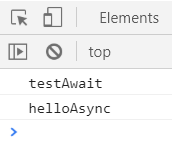
- await后面可以是Promise对象,也可以是字符串,布尔值,数值以及普通函数。
例4:await后为非Promise对象
function testAwait(){
setTimeout(function(){
console.log("testAwait");
}, 1000);
}
async function helloAsync(){
await testAwait();
console.log("helloAsync");
}
helloAsync();
执行结果:
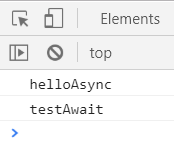
方法没有报错,说明await后面是支持非Promise函数的,但是执行的结果是不一样的,所以await针对所跟的表达式不同,有两种处理方式:
-
对于Promise对象,await会阻塞主函数的执行,等待 Promise 对象 resolve,然后得到 resolve 的值,作为 await 表达式的运算结果,然后继续执行主函数接下来的代码。
-
对于非Promise对象,await等待函数或直接量的返回,而不是等待其执行结果。
例5:将Promise对象变为rejected的处理
function testAwait(){
return Promise.reject("error");
}
async function helloAsync(){
await testAwait();
console.log("helloAsync"); //没有打印
}
helloAsync().then(function(v){
console.log(v);
}).catch(function(e){
console.log(e); //"error"
});
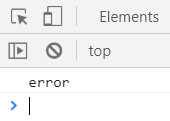
- 从执行结果看,返回reject状态被外层的catch捕获到,然后终止了后面的执行
例6:在有些情况下,出错后是希望继续执行,而不是中断。这种情况可以采用try…catch在函数内部捕获异常
function testAwait(){
return Promise.reject("error");
}
async function helloAsync(){
try{
await testAwait();
}
catch(e){
console.log("this error:"+e); //this error:error
}
console.log("helloAsync"); //helloAsync
}
helloAsync().then(function(v){
console.log(v); //undefined
}).catch(function(e){
console.log(e);
});
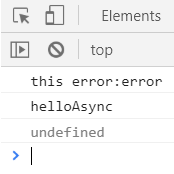
- 异常被try…catch捕获后,继续执行下面的代码,没有导致中断
三、应用场景
await可以阻塞主函数,直到后面的Promise对象执行完成。这个特性就能很轻松的解决按顺序控制异步操作,即异步流程的问题。
在Generator中肚包鸡的制作过程的实例,现在用async/await来重写这个例子:
//准备
function prepare(){
return new Promise((resolve) => {
setTimeout(function(){
console.log("prepare chicken");
resolve();
},500)
});
}
//炒鸡
function fired(){
return new Promise((resolve) => {
setTimeout(function(){
console.log("fired chicken");
resolve();
},500)
});
}
//炖鸡
function stewed(){
return new Promise((resolve) => {
setTimeout(function(){
console.log("stewed chicken");
resolve();
},500)
});
}
//上料
function sdd(){
return new Promise((resolve) => {
setTimeout(function(){
console.log("sdd chicken");
resolve();
},500)
});
}
//上菜
function serve(){
return new Promise((resolve) => {
setTimeout(function(){
console.log("serve chicken");
resolve();
},500)
});
}
async function task(){
console.log("start task");
await prepare();
await fired();
await stewed();
await sdd();
await serve();
console.log("end task");
}
task();
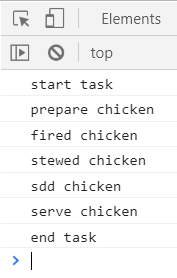
分析代码:
-
首先每个制作异步过程封装成Promise对象。
-
利用await阻塞原理,实现每个制作的顺序执行。
相比较Generator实现,无需run流程函数,实现了异步流程。





















 2742
2742

 被折叠的 条评论
为什么被折叠?
被折叠的 条评论
为什么被折叠?








